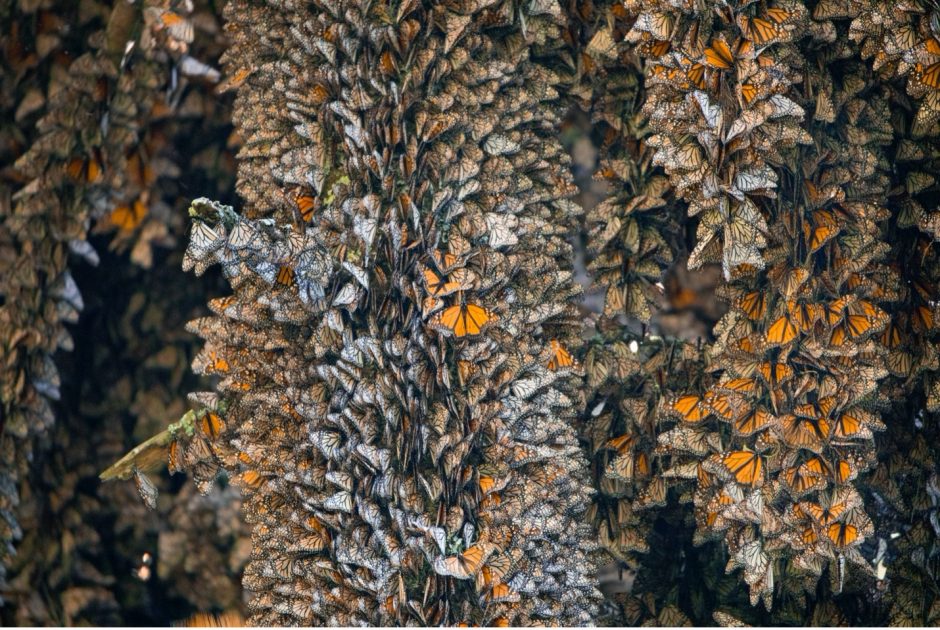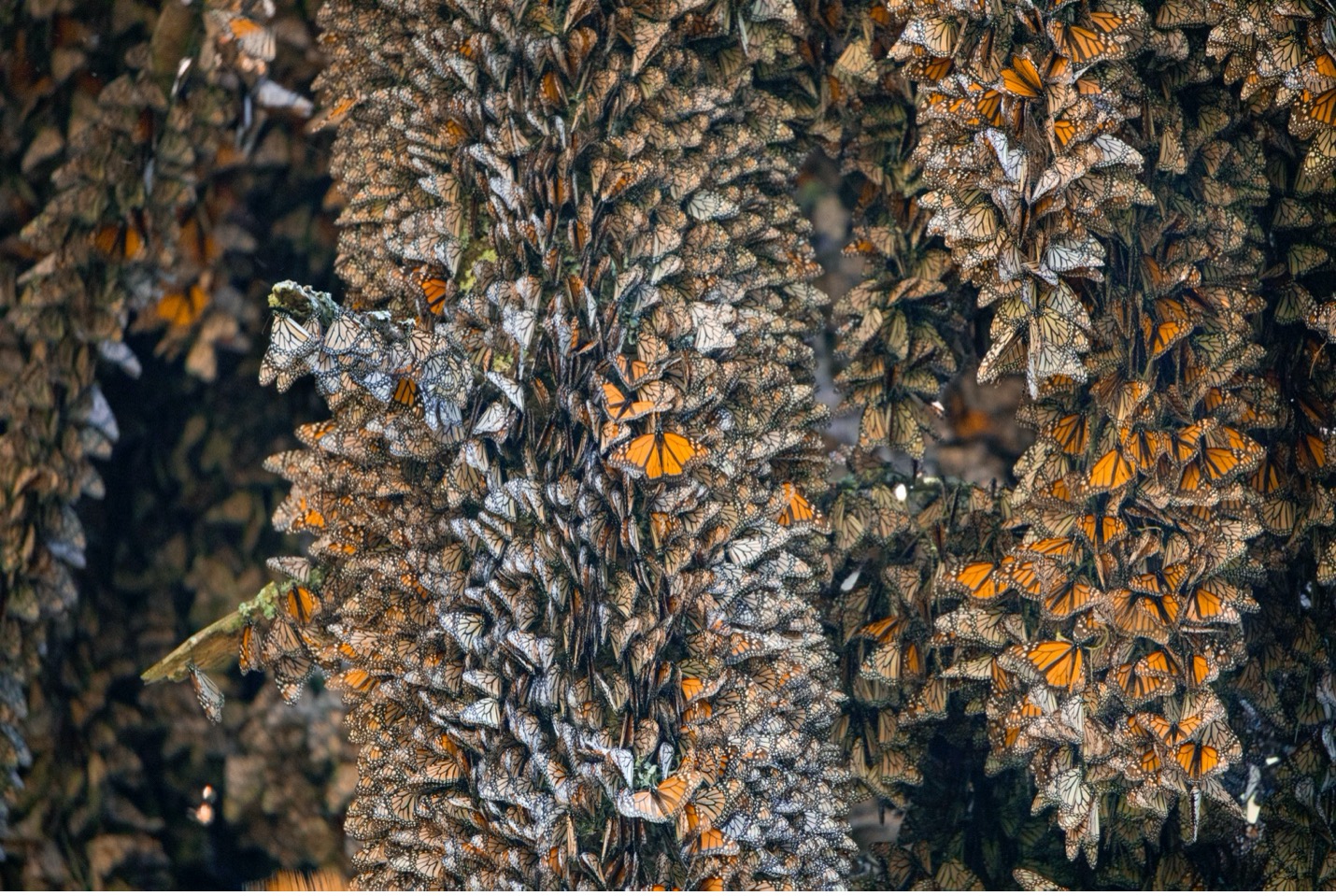
How to Get a “Filling-the-Frame” Monarch Butterfly Photo
The monarch migration is no doubt one of the most extraordinary things on our planet. The sheer volume and quantity of these orange and black butterflies will astound even the most experienced nature photographer.
On the surface, it seems relatively simple to capture photographically. How could you go wrong photographing millions of butterflies in the gorgeous fir and pine forests of Central Mexico?
While you certainly can just “point and shoot” and capture a variety of highly captivating scenes, specific shots require more deliberate thinking and strategy. In fact, what I view as one of the most iconic shots of the migration—butterflies blanketing the tree trunks and fir boughs—is harder than you’d think.
Follow these steps to nail the shot and come home with this incredibly alluring image that does so well as showcasing the individual beauty of the monarch while also highlighting the uniqueness of the phenomenon by exhibiting their numbers and density all around you.
Start with a zoom telephoto lens
This usually is the most unexpected step in photographing monarchs. For some reason, most folks instantly think small butterfly, lots of them, all I need is a wide angle. This just isn’t the case. Not for this shot, and frankly, not for most shots of the monarch migration in Mexico.
For this specific style of photo, a telephoto lens is essentially required. The reason is that you must find specific clusters of butterflies in the trees, and the ideal cluster (we’ll get to what “ideal” is in a bit) may be way high in a tree or across a small ravine.
In other words, there’s a high probability you can’t get close to it and thus must rely on your telephoto.
But fear not—the telephoto is going to give you even more flexibility here, so embrace it and get it on your camera (for those of you with point and shoots, embrace the zoom!)
Finding the ideal cluster of monarchs

This is just as critical as having a zoom telephoto on your camera. But what exactly is ideal? Wouldn’t this photo work well with any dense grouping of monarchs? Nope—and here’s why.
The primary issue here is lighting. Simply put, you must find a cluster of monarchs that is evenly lit, with a strong preference for evenly lit in the shade. This photo can also work in direct sunlit conditions, but in my opinion that’s no where near as good as when they’re in the shade, for this allows you to bypass any highlights and strong shadows from these wingy critters.
Notice how in the below photo there are so many highlights or bright spots that are somewhat distracting? It’s still a neat photo, but if we found monarchs without the intense lighting, it’d be better.

So, your mission is to scan all the trees and all the trunks to find a patch of monarchs that are thick, forming a nice pattern, and in evenly lit shade. You’ve often presented with a scene like the below, so there is lots of scanning opportunities!

How big of cluster of monarchs really depends on your vision for the shot, as well as how much telephoto power you have.
If you have only a moderate telephoto lens like a 70-200 or 70-300, you may need to find a big cluster, as you will be limited with how far you can zoom in in order to fill the frame. But if you have a more powerful telephoto like a 100-400 or 200-600, you have much more versatility such that you may be able to zero in on very small patches of monarchs.
To me, you have an advantage if you do indeed have a big telephoto, as there are usually many more opportunities to photograph evenly lit bunches of monarchs when you aren’t looking for a big area. As you’ll see if you join a monarch photo adventure, the lighting is incredibly mottled in the monarch groves. With all the branches and towering fir trees, there are so, so many areas of light and dark that it can be challenging to find sizeable areas of evenly lit conditions.
Once again, a good zoom telephoto lens helps tremendously here.

Dial in your settings and compose your shot
Because you’re going to be filling the frame with monarchs from edge to edge, most likely all monarchs will be relatively equidistant from your lens. That is, you can use a somewhat moderate aperture and ensure that all monarchs are in focus. However, because your entire frame consists of the butterflies, even small differences in distance can be out of your depth of field range if you’re using small f/numbers like f/2.8 or f/4.
My sweet spot is usually f/8. And while I sometimes experiment with f/11, usually there is just not enough light to allow me to get that small on my aperture while maintaining a decently fast shutter speed. You’ll be surprised how dark it can be in the shadowy areas of the monarch groves! I usually am already at a considerably high ISO like 1600 and higher, so f/11 would require me to double my ISO, and that’s something I’m always very sensitive to and avoid when possible.
You must also contend with moving butterflies, so your shutter speed should be something at least 1/320 and preferably higher. But it’s going to get hard to have it all! This is another reason why the shadowy areas of the colony are great to photograph—in the shade the monarchs are far less active and thus may not be moving much at all.

Your composition is actually one of the least critical things about this photo. While everything else I’ve discussed above is rather critical—a telephoto lens, an evenly lit patch of dense monarchs, and an aperture around f/8. However, with composition, my advice is to shoot a tad wider than you think you should and plan on cropping and reframing on your computer.
Small differences in which monarchs are in the frame, at the edge, in the center, are there leading lines, branches, etc. does indeed make a difference, but these things can be hard to ascertain perfectly in the moment.
By shooting a bit wider, you give yourself the flexibility to crop and recompose later, when you have a big monitor to review things on.
Shoot and repeat, over and over
The key to really nailing the shot is to do this over and over again—in the same area with the same group of monarchs, as well as other groups in other areas.
The best photo will come from that lucky moment when everything stacks up just right, but the only way to get that is to take multiple photos. Your best asset at this point is your eye, so look for those shaded clusters and take lots of shots!
Go forward and give it a shot!

Court
Leave a reply